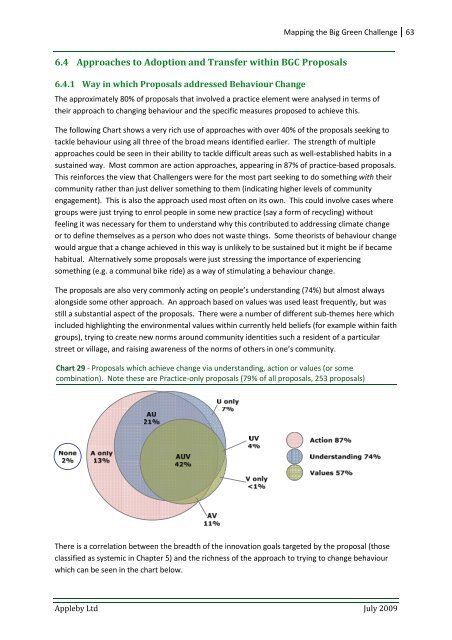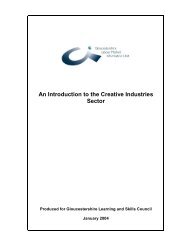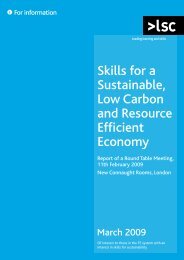Mapping the Big Green Challenge - The Skills & Learning ...
Mapping the Big Green Challenge - The Skills & Learning ...
Mapping the Big Green Challenge - The Skills & Learning ...
You also want an ePaper? Increase the reach of your titles
YUMPU automatically turns print PDFs into web optimized ePapers that Google loves.
<strong>Mapping</strong> <strong>the</strong> <strong>Big</strong> <strong>Green</strong> <strong>Challenge</strong> 636.4 Approaches to Adoption and Transfer within BGC Proposals6.4.1 Way in which Proposals addressed Behaviour Change<strong>The</strong> approximately 80% of proposals that involved a practice element were analysed in terms of<strong>the</strong>ir approach to changing behaviour and <strong>the</strong> specific measures proposed to achieve this.<strong>The</strong> following Chart shows a very rich use of approaches with over 40% of <strong>the</strong> proposals seeking totackle behaviour using all three of <strong>the</strong> broad means identified earlier. <strong>The</strong> strength of multipleapproaches could be seen in <strong>the</strong>ir ability to tackle difficult areas such as well-established habits in asustained way. Most common are action approaches, appearing in 87% of practice-based proposals.This reinforces <strong>the</strong> view that <strong>Challenge</strong>rs were for <strong>the</strong> most part seeking to do something with <strong>the</strong>ircommunity ra<strong>the</strong>r than just deliver something to <strong>the</strong>m (indicating higher levels of communityengagement). This is also <strong>the</strong> approach used most often on its own. This could involve cases wheregroups were just trying to enrol people in some new practice (say a form of recycling) withoutfeeling it was necessary for <strong>the</strong>m to understand why this contributed to addressing climate changeor to define <strong>the</strong>mselves as a person who does not waste things. Some <strong>the</strong>orists of behaviour changewould argue that a change achieved in this way is unlikely to be sustained but it might be if becamehabitual. Alternatively some proposals were just stressing <strong>the</strong> importance of experiencingsomething (e.g. a communal bike ride) as a way of stimulating a behaviour change.<strong>The</strong> proposals are also very commonly acting on people’s understanding (74%) but almost alwaysalongside some o<strong>the</strong>r approach. An approach based on values was used least frequently, but wasstill a substantial aspect of <strong>the</strong> proposals. <strong>The</strong>re were a number of different sub-<strong>the</strong>mes here whichincluded highlighting <strong>the</strong> environmental values within currently held beliefs (for example within faithgroups), trying to create new norms around community identities such a resident of a particularstreet or village, and raising awareness of <strong>the</strong> norms of o<strong>the</strong>rs in one’s community.Chart 29 - Proposals which achieve change via understanding, action or values (or somecombination). Note <strong>the</strong>se are Practice-only proposals (79% of all proposals, 253 proposals)<strong>The</strong>re is a correlation between <strong>the</strong> breadth of <strong>the</strong> innovation goals targeted by <strong>the</strong> proposal (thoseclassified as systemic in Chapter 5) and <strong>the</strong> richness of <strong>the</strong> approach to trying to change behaviourwhich can be seen in <strong>the</strong> chart below.Appleby Ltd July 2009











